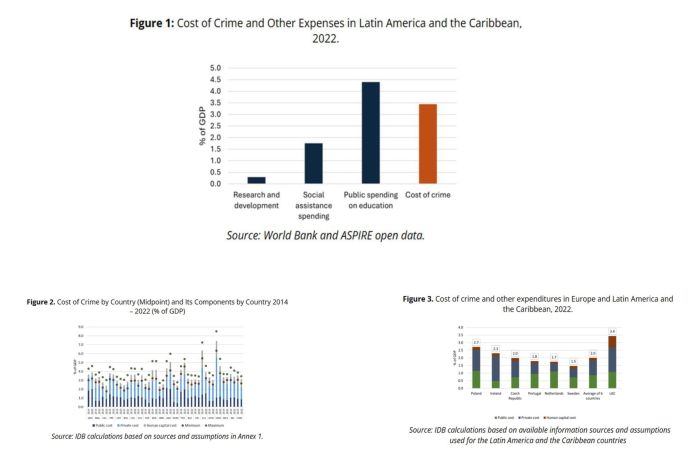– Direct costs of crime in 2022 reached 3.44 percent of the region’s GDP, mostly unchanged from previous study.
– The cost of crime is equivalent to 78 percent of the public budget for education, double the public budget for social assistance, and 12 times the budget for research and development.
– Preventive strategies and implementing evidence-based security and justice policies are essential to address causes of crime
WASHINGTON, USA – Latin America and the Caribbean social and economic development remains heavily burdened by crime and violence, a new Inter-American Development Bank (IDB) study shows. The direct costs of crime and violence in Latin America reached 3.44 percent of the region’s Gross Domestic Product (GDP) in 2022, mostly unchanged from a previous IDB study published in 2017.
“Our study shows that crime is a significant burden on our societies and economic development. It limits growth, drives inequality, and diverts private and public investment. We must join and redouble efforts to change that reality,” said Ilan Goldfajn, IDB president. “Evidence shows that targeted prevention and effective security and justice systems are key to lasting change. The IDB practical experience working with countries shows that we can mitigate the impact of crime. We are scaling our impact in this area by establishing a Regional Alliance for Security, Justice and Development,” he concluded.
The study, “The Costs of Crime and Violence: Expansion and Update of Estimates for Latin America and the Caribbean,” calculates the direct cost of crime in three areas: loss of human capital (costs of productive time lost as a result of non-lethal crimes, homicides and incarcerations), spending on crime mitigation by businesses, and public spending on crime prevention and criminal justice. In 2022, security expenses by private businesses accounted for 47 percent of the total cost of crime, while state spending on crime prevention represented 31 percent and the loss of human capital made up 22 percent.
The research also compares the direct cost of crime in Latin America and the Caribbean with six European countries – Poland, Ireland, Czech Republic, Portugal, Netherlands, and Sweden – where costs average 2 percent of GDP (42% less than Latin America and the Caribbean). Reducing the cost of crime to these levels would give Latin American and the Caribbean the equivalent of nearly 1 percent of GDP to invest in social welfare programs.
The report expands, updates, and refines the estimates presented in 2017. It uses a new methodology to estimate the cost in human capital based on local information about victim demographics for the calculation of the present value of economic losses from the premature death of homicide victims.
Additionally, the study presents an analysis of the indirect costs of crime such as reduced investment, lower business productivity and increased emigration. This analysis of indirect costs highlights why addressing crime requires restoring a sense of security and stability in addition to reducing the number of violent crimes.
The study offers key public policy recommendations for the region. These include strengthening public institutions to improve spending efficiency, focusing on evidence-based interventions, and strengthening justice systems while investing in education and social services to address the root causes of crime, especially in high-risk areas. And it emphasizes the importance of improving data collection and research to better understand crime and violence.
These are precisely some of the policies that the IDB seeks to promote through the Alliance for Security, Justice, and Development, an initiative that, in addition to facilitating regional coordination for the implementation of public policies, aims to promote resource mobilization to address, with a new approach, the challenges to economic and social development posed by organized crime.
It includes three case studies showing the impact of crime on tourism, migration, and business productivity in the region. It also presents the results for the year 2020 to analyze the dynamics during the COVID-19 pandemic, noting a slight increase of 0.09 percent compared to 2019 and 2021. This indicates that, despite the focus on the health emergency, crime continued to demand economic resources.





